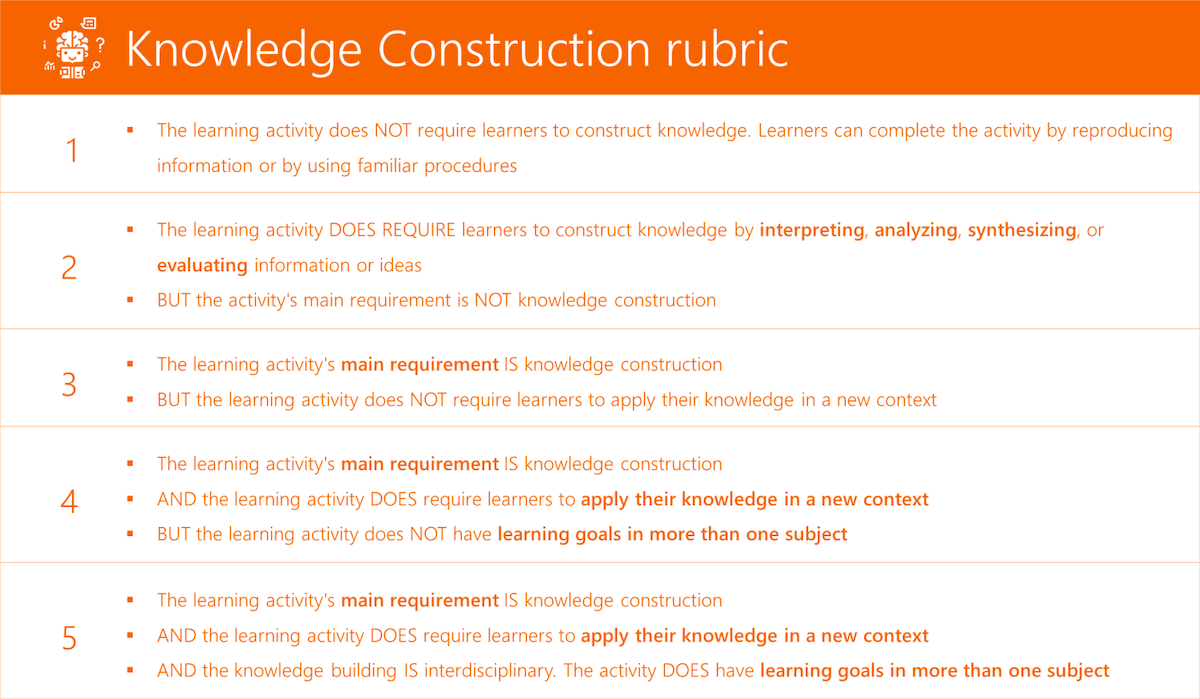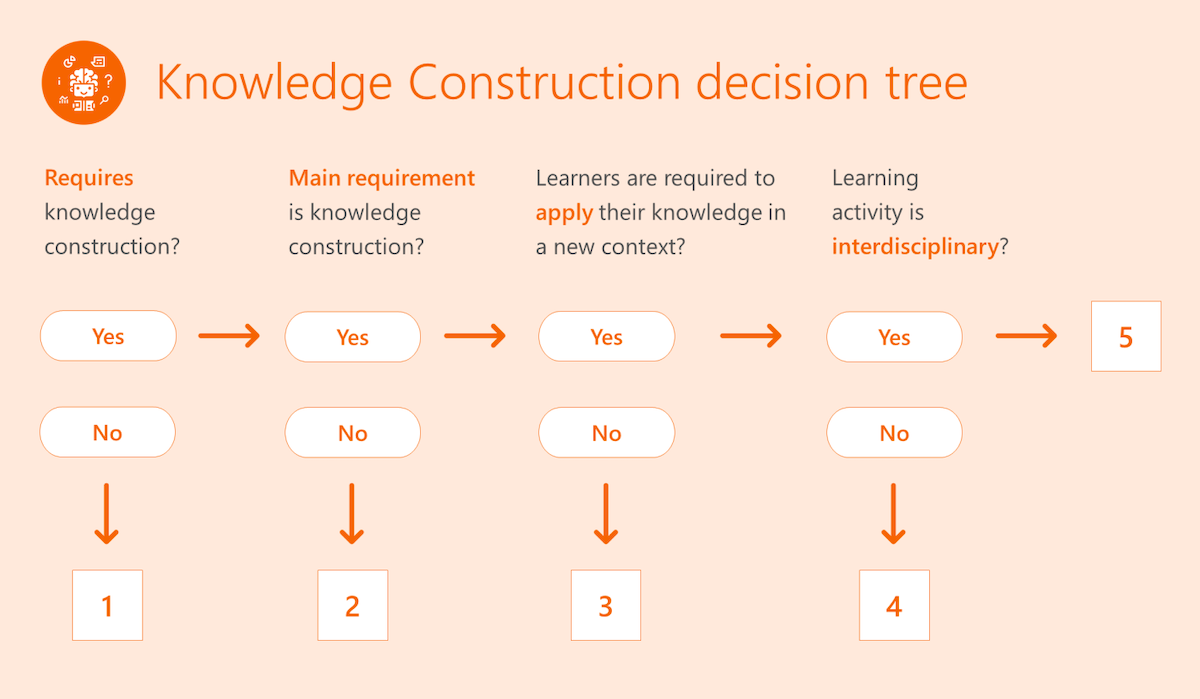Design learning experiences with the knowledge construction rubric
The 21CLD knowledge construction rubric explores whether learners construct and apply knowledge and if that knowledge is interdisciplinary. Knowledge construction occurs when learners do more than reproduce what they learned. They go beyond technology production to generating ideas and understandings that are new to them. Therefore, the skill of knowledge construction is often also referred to as critical thinking.
The knowledge construction rubric captures the big ideas of the dimension and is a useful framework when designing learning activities. The varied levels of the knowledge construction rubric (one to five) are:

Go to Rubric – Knowledge Construction for an accessible version of this rubric.
The knowledge construction decision tree poses four questions that correspond to the rubric. Educators must consider these questions when designing learning activities to deepen knowledge construction:
- Does the learning activity require knowledge construction?
- Is knowledge construction the main requirement?
- Are learners required to apply their knowledge in a new context?
- Is the learning activity interdisciplinary?

Go to Decision Tree – Knowledge Construction for an accessible version of this decision tree.
Does the learning activity require knowledge construction?
Activities that require knowledge construction ask learners to interpret, analyze, synthesize, or evaluate information or ideas.
- Interpretation means drawing inferences beyond the literal meaning. For example, learners might read a description of a historical period and infer why people who lived then behaved the way they did.
- Analysis means identifying the parts of a whole and their relationships to one other. For example, learners might investigate local environmental factors to determine which are most likely to affect migrating birds.
- Synthesis means identifying the relationships between two or more ideas. For example, learners might be required to compare and contrast perspectives from multiple sources.
- Evaluation means judging the quality, credibility, or importance of data, ideas, or events. For example, learners might read different accounts of a historical event and determine which ones they find the most credible.
Not all learning activities that are commonly described as research involve knowledge construction. Learners who look up information and then write a paper that describes what they found are merely reproducing knowledge—not constructing knowledge. They are not interpreting, analyzing, synthesizing, or evaluating anything. If, however, they write a paper comparing and contrasting information from multiple sources, they are constructing knowledge.
Additionally, if an activity asks learners to practice a procedure they already know, or if the activity gives learners a set of steps to follow, the activity doesn't require knowledge construction. To determine whether learners might already know a certain procedure, consider what is typically expected of learners of their age.
The following scenarios don't qualify as knowledge construction:
- Learners writing a paper describing the crime a character committed
- Learners using Bing to search the internet for information about local activities to help the environment and giving a presentation to describe what they found
- Learners familiar with the barometer using one to measure atmospheric pressure
- Learners who have already learned the definition of "parallel" using the definition to decide whether several sets of lines are parallel
The following scenarios qualify as knowledge construction:
- Learners using details in a story to infer the reasons why a character committed a crime
- Learners using Bing to search the internet for information about local activities to help the environment and analyzing it to find additional ways to help
- Learners comparing different explanations for changes in atmospheric pressure to determine which explanations are credible
- Learners who have not learned about parallel lines examining several different pairs of lines to develop a definition of "parallel"
Is knowledge construction the main requirement?
The main requirement is the part of the activity that learners spend the most time and effort on and the part that educators focus on when grading. If the learning activity does not specify how much time learners spend on each part, use professional judgment to estimate how long learners are likely to spend on different tasks.
In the following scenarios, the main requirement isn't knowledge construction:
- Learners spending 35 minutes listing details from a story and then spending 10 minutes using those details to infer why a character committed a crime
- Learners earning 70% of their grade for finding information and 30% for analyzing what they find
In the following scenarios, the main requirement is knowledge construction:
- Learners spending 10 minutes listing details from a story and then spending 35 minutes using those details to propose why a character committed a crime
- Learners earning 30% of their grade for finding information and 70% for analyzing what they find
Are learners required to apply their knowledge in a new context?
Learners apply their knowledge when they use the knowledge they have constructed in another knowledge construction task in a new context. For example, learners in a physics class might construct knowledge about heat principles from a study of the earth's inner core and then apply that new learning to investigate the environment of Jupiter. The second knowledge construction task deepens understanding because learners abstract what they learned to apply it in another situation.
It's not enough for the two contexts to differ only in surface features. Learners can't respond to the new situation simply by applying the same formula. They must use interpretation, analysis, synthesis, or evaluation to decide how to use what they learned in the new context.
The following scenarios don't require learners to apply their knowledge in a new context:
- Learners analyzing demographic statistics from their hometown and then analyzing demographic statistics from a second location of their choice
- Learners examining photos enlarged at different sizes to develop an understanding of similarity and then describing their understanding
- Learners in theater class analyzing the characters in a play to learn about character development and then writing an essay about what they learned
- Learners designing and executing a procedure for testing the qualities of the tap water at their school, testing the water, and redesigning the procedure iteratively until they have accurate data
The following scenarios require learners to apply their knowledge in a new context:
- Learners analyzing demographic statistics from their hometown and then using their understanding of population trends to develop a plan for an upcoming housing development project
- Learners examining photos enlarged at different sizes to develop an understanding of similarity and then applying that knowledge to abstract geometric shapes, thinking about size, ratios, and angles to determine which shapes are mathematically similar
- Learners in a theater class analyzing the characters in a play to learn about character development; then using Microsoft Video Editor to create their own one act play demonstrating character development
- Learners designing and executing a procedure for testing the qualities of the tap water at their school, and once they have accurate data, using that information to determine which water filtration system would be most appropriate for the school
Is the learning activity interdisciplinary?
Interdisciplinary learning activities have learning goals that involve content, important ideas, or methods from different academic subjects such as mathematics and music, or language arts and history. Subjects that are typically taught together do not count as interdisciplinary for the purposes of this rubric.
Additionally, even though learners often use ICT (Information & Communication Technologies) as a tool for learning in other subjects, ICT is not considered a separate academic subject within this rubric. For example, learners might build ICT skills when they do online research for a history project, but this activity isn't considered interdisciplinary.
The following scenarios aren't interdisciplinary:
- Learners in science class writing persuasive letters to an environmental organization about the results of their experiment, and educators grading students only on the quality of their data
- Learners in science class plotting points on a graph and no learning goals for math are defined
- Learners in physics using ICT to present their work to the class
The following scenarios are interdisciplinary:
- Learners in science class writing persuasive letters to an environmental organization about the results of their experiment, and educators grading students on the quality of their data and their writing skills
- Learners in science class plotting points on a graph and learning goals for both math and science are defined
Now, practice coding one of the anchor lessons in the 21CLD OneNote notebook by doing the following:
- Review The American Dream – Let America Be America Again learning activity page
- Consult either the knowledge construction rubric or decision tree and code the lesson
- If working with colleagues during this module, discuss your findings
- Play the video to compare your analysis with Becky's
Bonus: To better prepare for the Microsoft Certified Educator Exam, practice coding more anchor lessons. Suggested activities in the anchor lesson section:
- House on Mango Street
- Design a Catapult
- Indigenous Cultures
When you finish coding the lesson, review the coding results summary in the anchor lesson section to compare your findings to others.